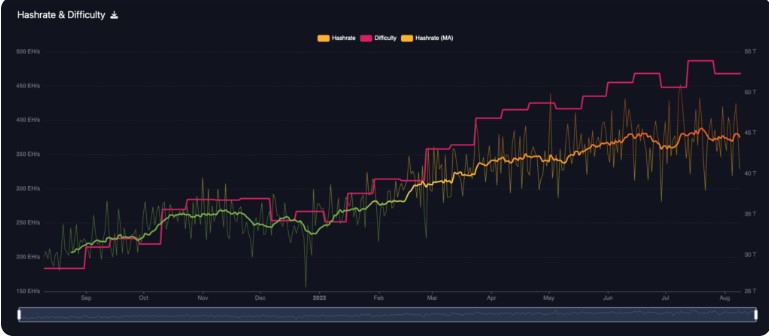Bitcoin (BTC) mining difficulty adjustment is known as a protocol feature created by Satoshi Nakamoto, which aims to maintain an average interval of about 10 minutes between each new block filled with transactions and added to the blockchain. This adjustment directly affects the profitability of mining, as increasing difficulty also means increasing costs for operations.
Bitcoin Mining Profitability
With the continuous increase in mining difficulty over time, Bitcoin miners are essentially working underwater. This is because the average cost of mining a single BTC has been higher than the average price of 1 BTC in the spot market since August 2022.
The average mining cost has been calculated by Cambridge University and displayed in a graph by MacroMicro. On August 8th, a cost of $34,835 per mined BTC was recorded, compared to the spot price of $29,902 on August 9th. This translates to a loss of $4,933 per unit of the leading cryptocurrency produced.
The highest average cost recorded in a one-year period was $49,415 on July 17th, resulting in a loss of approximately $19,270 per mined BTC at the same day’s price of $30,145 per BTC.

Apart from a few daily deviations in the graph, Bitcoin miners have mostly been mining at a loss, according to the presented data. This has led mining operations to protect their positions with financial products such as energy futures contracts.
The most affected entities by this situation are small and medium-sized Bitcoin miners who cannot sustain profitable operations and lose their market share and hashrate to larger miners within a scale economy dynamic.
As reported by CBS News, the latest difficulty adjustment came amidst the energy crisis in Texas, one of the world’s leading centers for Bitcoin mining. This has made energy more expensive.
Bitcoin Mining Difficulty at 52.39 Trillion
Block height 802368 was confirmed on August 9th with a positive adjustment of 0.10% in mining difficulty. Now, a block requires 52.39 trillion hashes to be considered valid. On June 11th (block number 798336), the difficulty level reached an all-time high of 53.91 trillion (+6.45%), then decreased to 52.33 trillion hashes (-2.94%) on July 26th (block number 800352). However, this metric is still above historical data.
Difficulty adjustments are considered directly related to hashrate dynamics. The more proof-of-work (PoW) calculations, measured by hashrate, are made by Bitcoin miners, the higher the chance of finding a valid block within a shorter time frame of 10 minutes. The opposite is also true: less hashrate in the network means longer intervals between blocks.

What is Mining Difficulty?
Mining, through the proof-of-work system, is the method chosen to secure the Bitcoin network and distribute new BTC to entities that provide work and resources. To guarantee a distribution up to the maximum limit of 21 million and control the controlled inflation of the circulating BTC supply, the Bitcoin protocol uses algorithms that help create a new block approximately every 10 minutes, along with the corresponding reward payment.
This algorithm works by adjusting the mining difficulty. When evaluating the frequency of discovering new blocks in the last 2,015 blocks, assuming an average of 10 minutes per block, it takes about two weeks. If the last 2,015 blocks have been mined in an interval shorter than 10 minutes, the mining difficulty needs to be increased.
This facilitates mining more blocks in a shorter period. The opposite can also occur. If the last 2,015 blocks have been discovered in an interval longer than 10 minutes, the mining difficulty needs to be decreased.
Although the adjustment is proportional to the computing power used on the network, it cannot exceed four times the previous value. In this case, the mining difficulty adjustment should always be less than 300% in an increase or less than 75% in a decrease. The mining difficulty is affected by adding or subtracting the number “zero” that must be placed to the left of other random characters.

 Türkçe
Türkçe Español
Español










